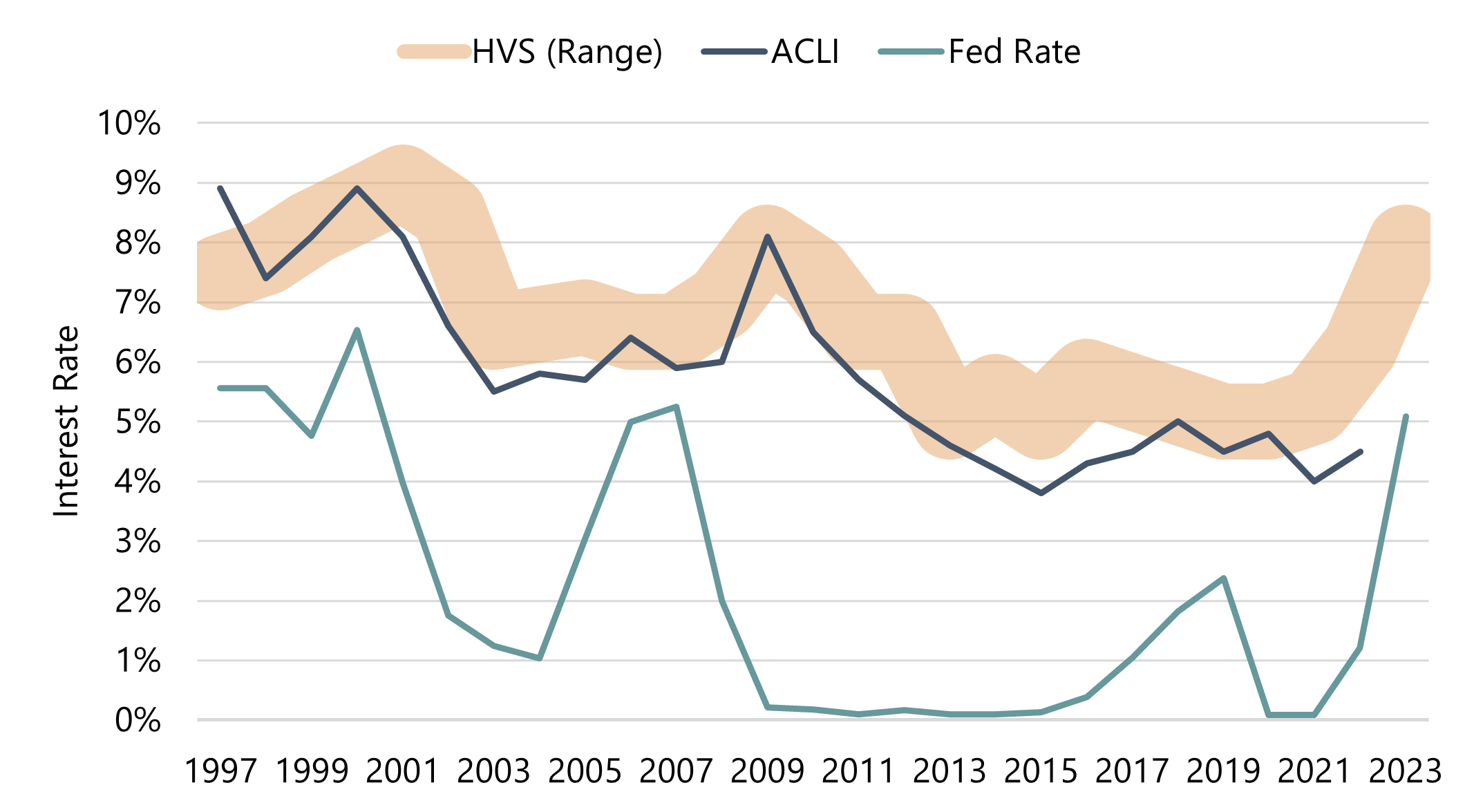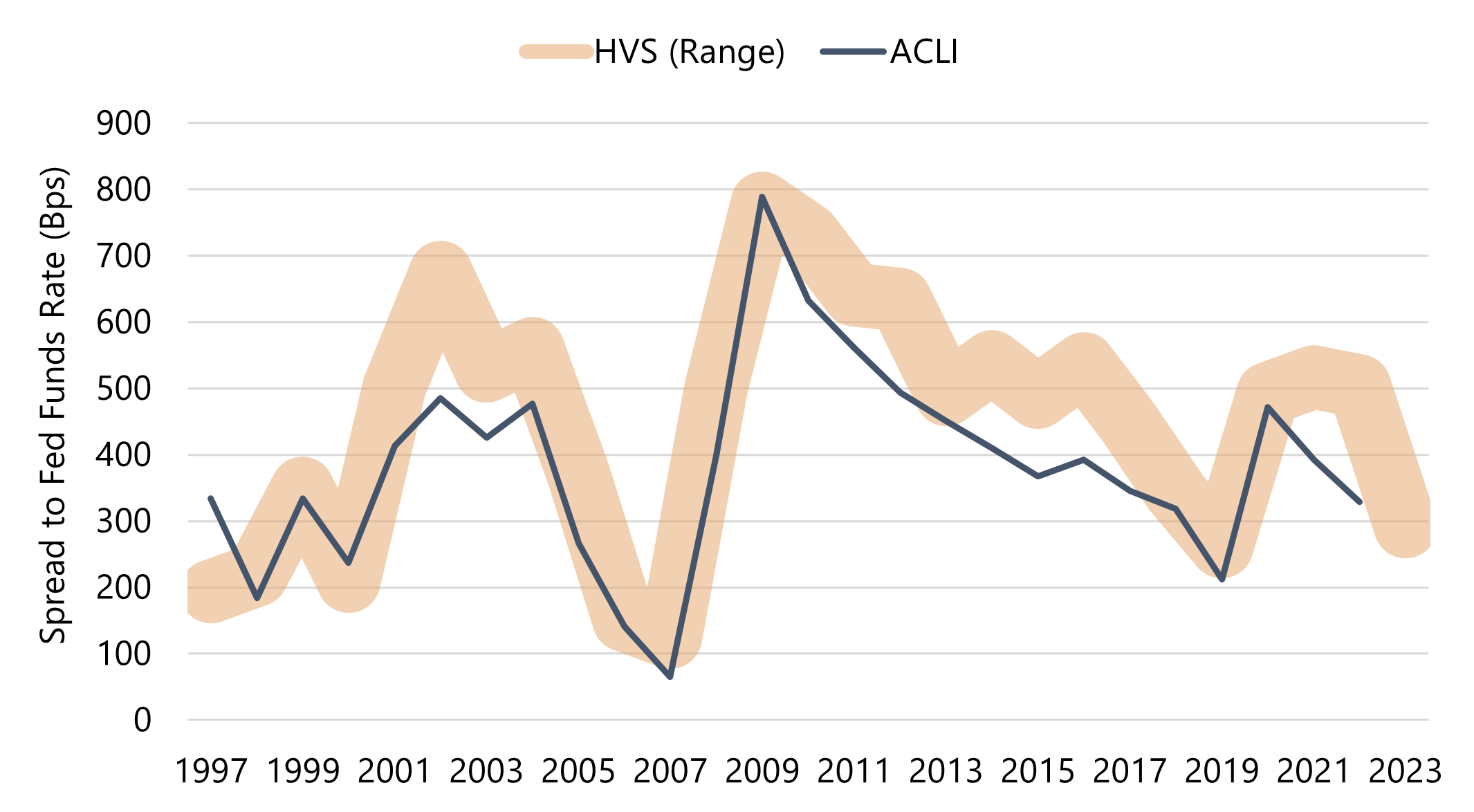 Over the past couple of months, it has become increasingly clear that interest rates for hotel financing, and just about everything else, may stay higher for longer. As markets adjust to this expectation, many investors are realizing that they may not be able to delay deals until rates drop back down to so-called “normal” levels. There is mounting pressure for financing decisions that will need to be made in the coming months. In this article, we have compiled and analyzed historical hotel interest rate data, as well as indications from the Federal Open Markets Committee (FOMC or “Fed”) on the anticipated direction of future interest rates, to help provide some context for the past, present, and future of the hotel financing market.
Over the past couple of months, it has become increasingly clear that interest rates for hotel financing, and just about everything else, may stay higher for longer. As markets adjust to this expectation, many investors are realizing that they may not be able to delay deals until rates drop back down to so-called “normal” levels. There is mounting pressure for financing decisions that will need to be made in the coming months. In this article, we have compiled and analyzed historical hotel interest rate data, as well as indications from the Federal Open Markets Committee (FOMC or “Fed”) on the anticipated direction of future interest rates, to help provide some context for the past, present, and future of the hotel financing market.
Interest Rate Trends & the Myth of “Normal”
In order to determine reasonable expectations for debt pricing in coming years, HVS has reviewed publicly available data for actual hotel mortgages made by members of the American Council of Life Insurers (ACLI). This data primarily represents loans on higher value assets that would be considered credit-worthy by those companies. Additionally, HVS continually tracks hotel mortgage lending trends through conversations with active market participants and a review of actual hotel mortgage terms across a wider swath of the hotel financing landscape. This monitoring of the hotel mortgage market is routinely tracked, discussed internally, and updated multiple times per year. The following chart illustrates trends in interest rates from 1997 through the latest year of data, as tracked by HVS and published by the ACLI, as well as the fluctuations in the federal funds rate over the same period. The HVS trendline in the table below reflects a range of interest rates rather than specific data points.Hotel Mortgage Interest Rates Compared to the Federal Funds Rate

Based on those considerations and a review of the data presented above, it is readily apparent that the idea of a “normal” interest rate is a fallacy. Over time, the federal funds rate has fluctuated significantly in response to macroeconomic conditions, which are substantially influenced by major, often unforeseen, events. In the time period shown, these have included the 9/11 terrorist attack, the Great Recession, and the COVID-19 pandemic. While the fluctuation in hotel interest rates has been slightly less volatile, it has generally followed the trend line of the Fed rate and offers no clear indication of a period of normalcy.
In addition to the comparison of rates presented above, it is also helpful to consider the spread of hotel interest rates in comparison to the Fed rate. The following chart illustrates the spread, in basis points, between the Fed rate and the hotel interest rates indicated by ACLI and HVS.
Spread Between Fed Rate and Hotel Interest Rates

Looking Ahead
Fortunately, the FOMC offers forward-looking guidance on their targeted rate. As of March 20, when the last guidance was issued, the targeted “long-run” rate was 2.5–2.75%. This level represents the Fed’s estimate of a neutral funds rate that neither stimulates nor inhibits economic growth. As seen in the charts above, the Fed has not zeroed in on such a rate in recent memory, but instead has alternated between stimulating rates following a crisis and inhibiting rates when growth becomes too strong. Nevertheless, the Fed’s forward-looking rate guidance can provide some indication of where hotel interest rates may be headed if all goes as planned in coming years.In consideration of the historical trends presented above, we have estimated a range of potential hotel interest rates that correlate to the FMOC’s projected target rate in coming years, as of March 20. These projections indicate that if the Fed decreases the funds rate as planned, hotel interest rates are not likely to decline to the levels recorded from 2013 to 2021. Hotel investors needing to originate a loan in the near term should not be overly concerned about timing the interest rate market. On the other hand, for those with a low interest rate locked in through 2025, it may be worthwhile to wait as long as possible to obtain new financing. Of course, as the data presented in the first chart indicate, interest rates do not typically trend smoothly in the intended direction for very long. The choice to delay financing until interest rates are much lower may also mean choosing to face whatever macroeconomic crisis causes them to fall that far.
About Daniel P. McCoy, MAI
As the HVS Practice Leader for the Midwest, Dan McCoy, MAI, oversees the firm's seven offices in this region. A Senior Managing Director at HVS, Dan is a recognized thought-leader, collaborative advisor, and invaluable resource for the Midwest's lodging industry. He combines a deep understanding of regional hotel markets with strong analytical thinking to provide a wide variety of clients with up-to-date hospitality intelligence and tailor-made solutions. Dan is a Designated Member of the Appraisal Institute (MAI) and a certified general appraiser. Contact Dan at +1 (970) 215-0620 or [email protected].


I really liked this article, very illuminating! Its so good to see that context of pre-2009 lending environment, it makes the rates going forward seem a lot more reasonable.
Excellent discussion, Dan...credible and reasonable outlook based on a long line of data.